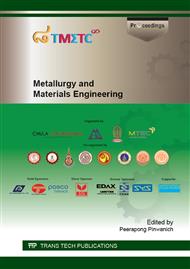[1]
K.H. Leong, P. Monash, S. Ibrahim, P. Saravanan, Solar photocatalytic activity of anatase TiO2 nanocrystals synthesized by non-hydrolitic sol–gel method, Solar Energy, 101 (2014) 321-332.
DOI: 10.1016/j.solener.2014.01.006
Google Scholar
[2]
Y. Hu, H.L. Tsai, C.L. Huang, Effect of brookite phase on the anatase rutile transition in titania nanoparticles, Journal of the European Ceramic Society, 23 (2003) 691–696.
DOI: 10.1016/s0955-2219(02)00194-2
Google Scholar
[3]
Z. He, Q. Cai, H. Fang, G. Situ, J. Qiu, S. Song, J. Chen, Photocatalytic activity of TiO2 containing anatase nanoparticles and rutile nanoflower structure consisting of nanorods, Journal of Environmental Sciences, 25 (2013) 2460-2468.
DOI: 10.1016/s1001-0742(12)60318-0
Google Scholar
[4]
Y.F. You, C.H. Xu, S.S. Xu, S. Cao, J.P. Wang, Y.B. Huang, S.Q. Shi, Structural characterization and optical property of TiO2 powders prepared by the sol–gel method, Ceramics International, 40 (2014) 8659-8666.
DOI: 10.1016/j.ceramint.2014.01.083
Google Scholar
[5]
K.H. Leong, P. Monash, S. Ibrahim, P. Saravanan, Solar photocatalytic activity of anatase TiO2 nanocrystals synthesized by non-hydrolitic sol–gel method, Solar Energy, 101 (2014) 321-332.
DOI: 10.1016/j.solener.2014.01.006
Google Scholar
[6]
C.H. Han, H.S. Lee, S.D. Han, Synthesis of Nanocrystalline TiO2 by Sol-Gel Combustion Hybrid Method and Its Application to Dye Solar Cells, Bulletin of the Korean Chemical Society, 29 (2008) 1495-1498.
DOI: 10.5012/bkcs.2008.29.8.1495
Google Scholar
[7]
M. H. Fathi and A. Hanifi, Sol–gel derived nanostructure hydroxyapatite powder and coating: aging time optimisation, Advances in Applied Ceramics, 108 (2009) 363-368.
DOI: 10.1179/174367609x414080
Google Scholar
[8]
F. Chen, J. Zhao, H. Hidaka, Photocatalytic Treatment of Rhodamine 6G in Wastewater Using Photoactive ZnO, International Journal of Photoenergy, 5 (2003) 209-217.
Google Scholar
[9]
K.V. Baiju and K.G.K. Warrier, Aqueous sol-gel process for nanocrystalline photocatalytic titania, transparent functional coatings and ceramic membrane. Diss. National Institute for Interdisciplinary Science and Technology, CSIR (2007).
Google Scholar
[10]
M. Babar Shahzad, Yang Qi, Hong Lu, Xiandi Wang, A study on the Al doping behavior with sol aging time and its effect on structural and optical properties of sol–gel prepared ZnO thin films, Thin Solid Films, 534 (2013) 242-248.
DOI: 10.1016/j.tsf.2013.02.126
Google Scholar
[11]
A. Beltran, L. Gracia, J. Andres, The electronic structure and optical response of rutile, anatase and brookite TiO2, Journal of Physics: Condensed Matter, 24 (2012) 195503.
DOI: 10.1088/0953-8984/24/19/195503
Google Scholar
[12]
J. Muscat, V. Swamy, N.M. Harrison, First-principles calculations of the phase stability of TiO2, Physical Review B, 65 (2002) 224112.
Google Scholar
[13]
M. Batzill, E.H. Morales, U. Diebold, Influence Of Nitrogen Doping On The Defect Formation and Surface Properties of TiO2 Rutile And Anatase, Physical Review Letters, 96 (2006) 26103.
DOI: 10.1103/physrevlett.96.026103
Google Scholar
[14]
J.M. Criado and C. Real, Mechanism of the inhibiting effect of phosphate on the anatase → rutile transformation induced by thermal and mechanical treatment of TiO2, Journal of the Chemical Society, Faraday Transactions 1, 79 (1983) 2765-2771.
DOI: 10.1039/f19837902765
Google Scholar
[15]
Dorian A. H. Hanaor and Charles C. Sorrell, Review of the anatase to rutile phase transformation, Journal of Materials Science, 46 (2011) 855-874.
DOI: 10.1007/s10853-010-5113-0
Google Scholar


